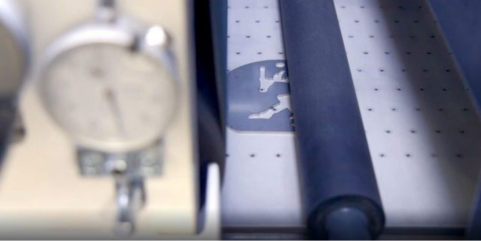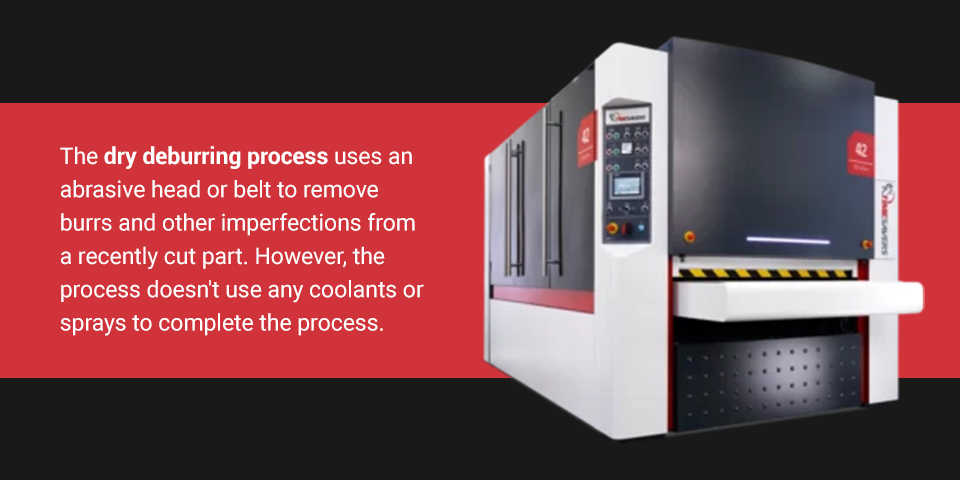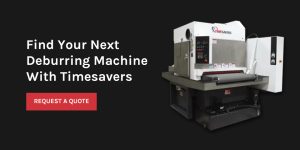Wet vs. Dry Deburring Machines

Machine processing innovations have become more advanced and efficient over the years. However, despite these innovations, components or parts usually still have leftover imperfections. Deburring involves removing the rough edges around processed parts or components. This metal finishing process is crucial to ensure you achieve the desired final product. It’s also essential for other processes, such as electroplating or powder coating. One common imperfection is the presence of burrs leftover from plasma, laser, flame and other cutting processes and the handling of parts.
There are two types of linear deburring systems — wet deburring systems and dry deburring systems. Understanding the differences between the wet and dry methods can help you choose the best option for your operation.
What Is Wet Deburring?
Wet deburring feeds parts through a conveyor belt and sprays them with coolant and finishes the part with abrasive materials. Wet deburring systems are generally composed of a conveyor with pinch rolls, which keep the parts in place, while the heads remove burrs and minor surface imperfections.
Spraying the component before the deburring process protects it from heat before moving through the abrasive heads due to the lubricity. Wet finishing or deburring usually works best with metals that produce a lot of dust. Below the machine is a filtration unit, which collects the swarf and fine particles through the filter paper and redistributes them up through the spray headers back onto the parts.
Pros and Cons of Wet Deburring
Wet deburring has many advantages for material processing. These machines eliminate the need for an external dust extraction unit since the liquids used in wet deburring filter out the dust.
- Allows users to process different metal types without the risk of flammable parts caused by sparks or dust found in dry deburring.
- Reduces the risk of warped parts since the process cools the materials.
- Improves corrosion resistance when using the correct type of coolant for wet deburring.
- Smaller footprint because of lack of dust collection unit.
- Increases abrasive belt life.
- Finer/better finish.
There are some cons to wet deburring processes that should also be considered.
- Neglecting routine and consistent maintenance can result in excessive corrosion and damaging critical components, but daily cleaning will ensure that the cleaning will maintain the machine’s longevity.
- Higher costs due to the price of chemicals and mixtures.
- The complexity of start-up may lead to longer lead times.

What Is Dry Deburring?
The dry deburring process uses an abrasive belt or brush to remove burrs and other imperfections from a recently cut part. The process doesn’t use any coolants or sprays to complete the process. The dry deburring creates more dust since the process relies on non-lubricated abrasion to remove flaws, such as vertical burrs, mill scale, handling scratches and pitting.
Dry deburring uses materials like belt heads, barrel brushes, top brushes and rotary brushes to complete the final product. Choosing different abrasive materials can help you achieve a unique finish, influenced by the metal used and its grit sequence in the machine. Dry deburring increases friction in an environment and the heat on the parts increases the risk of the parts being flammable, especially if you’re working with aluminum or titanium.
Pros and Cons of Dry Deburring
Like wet deburring, dry deburring has unique benefits and drawbacks to compare before choosing between the two methods. Some of the most notable benefits of dry deburring include:
- Fewer maintenance requirements compared to wet deburring and a longer-lasting system.
- Minimal costs to operate and acquire, making it a better choice for some operations.
- Ideal for production lines working with the same material or metal without the risk of explosion or fire.
- Access to a wet dust collector to remove dust from the system.
You may choose dry deburring systems for your operations to reduce costs and maintenance requirements. However, there are some additional items to be aware of before making a final decision.
- The increased risk of remaining dust particles on finished materials negates an extra cleaning step.
- Requires a wet dust extractor to operate safely.
- Higher risk of flammable parts due to a combination of metals in heated environments.
- While a dry deburring system could be suitable for your operations, it’s essential to consider what types of materials you’re working with, so you don’t unknowingly create a safety hazard.
- Higher abrasive cost due to having a non-lubricated abrasive process.
What to Consider When Choosing a Wet vs. Dry Deburring Machine
Wet and dry deburring methods have unique benefits and drawbacks, and every work environment is different. When you’re choosing between wet vs. dry deburring, your considerations should include the following:
- Materials: If you’re finishing more than one type of metal, especially aluminum or titanium, you should choose a wet deburring machine to reduce the risk of fire or cause severe bodily harm to the operators.
- Warping: Dry deburring machines can warp the final product due to heat exposure from contact with the drum. Wet deburring machines make sure that your parts aren’t contaminated by dust and warping through heat exposure.
- Maintenance and downtime: To ensure less downtime, in terms of maintenance, you may choose a dry deburring system. Wet deburring systems require more maintenance and daily cleanings to ensure safety and smooth operation, which can result in more downtime for your operations.
Find Your Next Deburring Machine With Timesavers
Whether you’re looking for wet or dry deburring machines for your processes, Timesavers can help. We have a wide selection of automated deburring equipment to meet every company’s needs. You can rely on our durable, versatile machines to have impressive life spans, which help you generate savings and reduce equipment maintenance.
We are leaders in the deburring machine industry, and you can trust us to help you find the highest-quality machinery with the latest abrasive technology to improve your processes. Request a quote with us today to learn how we can revolutionize your finishing.

